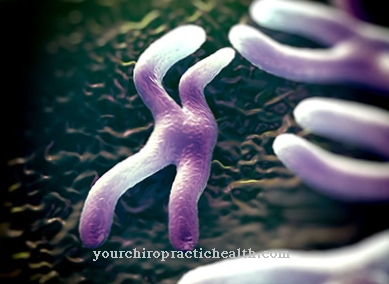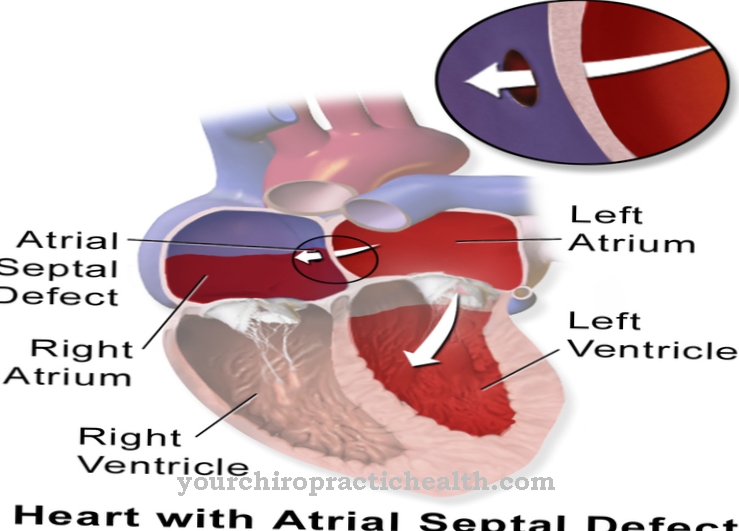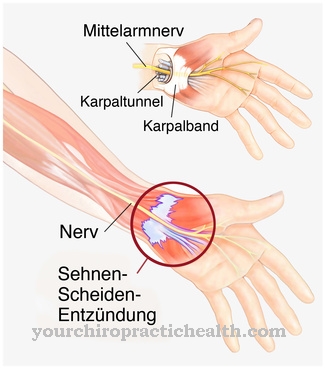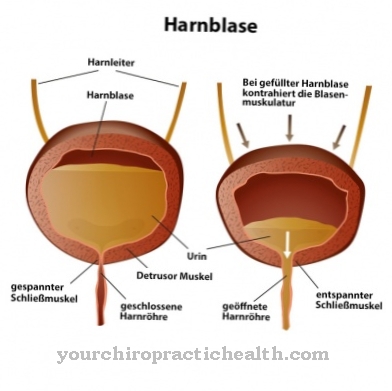As Klippel-Trenaunay-Weber Syndrome is a congenital malformation of the blood vessels. Those affected suffer from huge growth on their limbs.
What is Klippel-Trenaunay-Weber Syndrome?

© serhiibobyk - stock.adobe.com
At the Klippel-Trenaunay-Weber Syndrome it is a symptom complex that is innate. Malformations occur in the vascular system. Another characteristic is significant stunted growth on the arms and legs. The disease also bears the names Klippel-Trenaunay Syndrome, angiectatic giant growth or Angio-osteohypertrophic syndrome.
The Klippel-Trenaunay-Weber syndrome is congenital and only appears very rarely. So far, only around 1000 cases of illness have been documented. The syndrome was named after the French doctors Maurice Klippel (1858-1942) and Paul Trenaunay (1875-1938), who first described the disease. The English physician Frederik Parkes Weber (1863-1962) also contributed to this description.
causes
The exact causes of the Klippel-Trenaunay-Weber syndrome have not yet been clarified. It is known that in the first two months of pregnancy a disorder of vascular development occurs, which affects the blood and lymph vessels. This leads to the formation of vessels that are immature and not fully functional. The extent of the undesirable development varies from person to person. So there are always unique clinical pictures.
Disturbances in blood circulation and blood circulation can cause growth disorders in the affected parts of the body. In addition, various concomitant diseases such as an inclined position of the pelvis, scoliosis, functional impairment of the pelvic valves or knee osteoarthritis are possible in children.
Whether the excessive formation of vessels is the reason for the huge growth of the Klippel-Trenaunay-Weber syndrome could not be clearly established. Other causes may also come into consideration that are still unknown.
Symptoms, ailments & signs
The typical symptoms of Klippel-Trenaunay-Weber syndrome include vascular malformations. In addition, there is huge growth, which usually occurs on one side. In some cases, however, the opposite effect, i.e. short stature, can be observed. The deformities of the vessels are noticeable through lymphangiomas. These are benign tumors on the lymph vessels. Furthermore, fire marks form on the skin, which reach a striking size.
The huge growth also leads to hypoplasia or aplasia in the leg veins and the development of varicose veins. Soft tissue hypertrophy also occurs. Some people may have arteriovenous fistulas on their arms and legs. Since the legs of the patients have different lengths, those affected often suffer from gait disorders.
But there are other problems caused by the Klippel-Trenaunay-Weber syndrome in the realm of the possible. These include bleeding, among other things. While they occur in children only as a result of injuries, which can also be minor, older people suffer from spontaneous bleeding from dilated vessels. A blood clot (thrombosis) poses the risk of painful swelling of the limbs. In the worst case, the thrombosis can cause life-threatening pulmonary embolism.
Since the affected limb becomes more abundant in blood, increased sweats can occur there. Patients often find these extremely uncomfortable. Another common symptom is pain in the affected arm or leg. It is believed that the symptoms are caused by the accumulation of blood. It exerts pressure on the joint capsules, muscles or nerves.
Diagnosis & Therapy
Diagnosing Klippel-Trenaunay-Weber syndrome is complex. It is important to examine all of the body's vessels to determine the exact extent of the disease. For this reason, a sonography (ultrasound examination), a pressure measurement and an angiography are carried out on the arteries. An ultrasound scan will also take place on the veins.
In addition, a light reflex rheography, a phlebography and an occlusive plethysmography are carried out on them. Direct lymphography and lymph scintigraphy can be used to examine the lymph vessels. Doctors examine bones and soft tissues using x-rays, computed tomography (CT) or magnetic resonance imaging (MRI).
Which examination ultimately takes place differs from patient to patient. Due to the complexity of the vascular malformations, no cure for Klippel-Trenaunay-Weber syndrome can be achieved. In addition, a complete normalization of the vessels is considered impossible.
Complications
In most cases, the Klippel-Trenaunay-Weber syndrome leads to various malformations, which mainly occur in the blood vessels of those affected. It is not uncommon for a giant growth to occur, which mainly affects the patient's limbs. However, the person affected can also suffer from short stature.
The vessels are deformed and tumors develop on them. As a rule, however, the tumors are benign and stains can continue to develop under the skin. It is not uncommon for patients to suffer from gait disorders or other problems with walking or running. The legs can also have different lengths.
The Klippel-Trenaunay-Weber syndrome leads to increased bleeding and blood clots. In the further course of the disease, the patient can also develop a pulmonary embolism, which, if left untreated, can lead to the patient's death. The joints are affected by pain and there is generally a decrease in the patient's resilience.
The treatment of Klippel-Trenaunay-Weber syndrome takes place with the help of surgical interventions and can limit many complaints. In some cases, psychological treatment is also necessary, but this does not lead to any particular complications.
When should you go to the doctor?
Klippel-Trenaunay-Weber syndrome is often diagnosed immediately after the child is born. If this is not the case, the parents must inform the doctor as soon as any unusual symptoms or complaints are noticed. Signs of short or overgrown stature should always be clarified by a specialist. Fistulas, gait disorders or bleeding are also clear warning signs. Parents of affected children should speak to their pediatrician as soon as possible if one or more of the symptoms mentioned occur. This can examine the child and rule out or diagnose Klippel-Trenaunay-Weber syndrome.
If the KTWS is the basis, he will refer the parents to a specialist clinic for genetic diseases. The individual symptoms must be examined and treated by different specialists. A visit to the orthopedic surgeon is necessary for gait disorders, while skin changes should be presented to a dermatologist. Those affected are usually less resilient and more prone to bleeding and blood clots. Close medical supervision prevents medical emergencies and contributes to the child's rapid recovery. Medical therapy can be supported by therapeutic advice.
Therapy & Treatment
Treatment of Klippel-Trenaunay-Weber syndrome is not easy. In this way, neither healing nor restoration of the vascular system can be achieved. However, early detection in the first few years of life plays an important role. In this way, it is possible to avoid a severe course of the disease or long-term effects through timely treatment.
In some cases, operations are performed to remove excessively laid-back parts of the vasculature. These are mostly larger hemangiomas (blood sponges) or varicose veins. There is also the option of influencing the length growth of an arm or leg.
Individual vessels can be closed using a catheter. The targeted deactivation of veins or arteries that are too large is also possible. For this purpose, a small artificial plug or liquid plastic is injected. In addition, various lasers can be used to seal vessels on the surface or in deeper areas.
Physiotherapeutic measures such as lymphatic drainage or physiotherapy exercises are another therapeutic option. They are useful to improve joint mobility or the mobility of the limbs. Increased heels with shortened legs or compression stockings or compression sleeves help improve the quality of life. Psychotherapy can also be important as it helps patients cope better with their illness.
Outlook & forecast
The cause of the Klippel-Trenaunay-Weber syndrome has not yet been fully explained. As a result, the treatment measures are individual and no uniform therapy is applied. Although researchers and scientists are still working intensively on research into the causes, the decisive breakthrough has not yet occurred. Doctors receive the current knowledge of the medical professionals and try to integrate them in the best possible way when creating the treatment plan. The malformations of the vessels are treated according to the respective circumstances and often aim to alleviate symptoms. Complete recovery is often not achieved.
The beginning of the first therapy depends on the diagnosis and is decisive for the further course of the disease. The sooner action can be taken, the better the long-term results will be. Some patients have one or more surgical procedures. These are associated with the usual risks and side effects. If there are no further complications, the overall situation usually improves after an operation.
Patients with Klippel-Trenaunay-Weber syndrome must undergo long-term therapy over the entire life span. Regular check-ups are necessary in order to recognize changes at an early stage and to be able to react accordingly. The various stresses caused by the disease lead to psychological complications in some of those affected. These worsen the overall situation further and must be taken into account when making a forecast.
prevention
It is not possible to prevent the Klippel-Trenaunay-Weber syndrome. So it is a congenital disease. In addition, the exact causes of the syndrome could not be determined.
Aftercare
In the case of Klippel-Trenaunay-Weber syndrome, an early diagnosis of the disease should primarily be made so that the symptoms do not worsen further. An early diagnosis usually has a very positive effect on the further course, so that the person affected should consult a doctor at the first signs of the disease.
Since this syndrome is a genetic disease, genetic testing and counseling should be provided if you want to have children in order to prevent the syndrome from recurring. Most of those affected are dependent on the measures of physiotherapy and physiotherapy. Some of the exercises from these therapies can be repeated at home, which speeds up healing.
The support and help of other people or parents in the everyday life of the person concerned is also very important. This can also prevent possible psychological complaints or depression. In the case of Klippel-Trenaunay-Weber syndrome, regular examinations by a doctor are also very important so that further damage to the vessels can be detected early. Usually this disease does not reduce the life expectancy of those affected.
You can do that yourself
The possibilities of self-help are very limited in the Klippel-Trenaunay-Weber syndrome. An important point here is the early detection and diagnosis of the syndrome, as this can prevent further complications and serious complaints.
Therapy must therefore begin in the early years of life. Most of the complaints are usually corrected and alleviated by surgical interventions. After the surgical interventions, the patients are dependent on measures of physiotherapy and physiotherapy to restore the mobility of the limbs. The various exercises can usually be performed in your own home, which can accelerate the healing process. Furthermore, wearing compression stockings can have a positive effect on the course of the disease and alleviate possible restrictions in everyday life.
In general, however, patients are dependent on help in everyday life. Help from close friends or from your own parents and relatives has a positive effect on the course of the disease. In the case of psychological complaints, empathetic conversations with people you trust are also helpful. Often, contact with other people with Klippel-Trenaunay-Weber syndrome can also be helpful, as this leads to an exchange of information that can improve the quality of life. However, the early detection of the disease is still in the foreground.





.jpg)


















.jpg)



